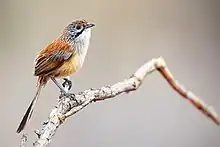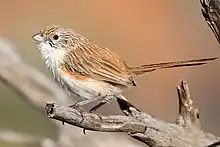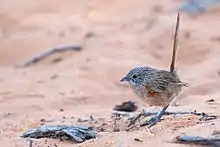| Grasswren | |
|---|---|
_on_branch_from_front.jpg.webp) | |
| Striated grasswren (Amytornis striatus) | |
| Scientific classification | |
| Domain: | Eukaryota |
| Kingdom: | Animalia |
| Phylum: | Chordata |
| Class: | Aves |
| Order: | Passeriformes |
| Family: | Maluridae |
| Genus: | Amytornis Stejneger, 1885 |
| Type species | |
| Malurus textilis[1] Dumont, 1824 | |
| Species | |
|
see text | |
| Synonyms | |
| |
Grasswrens (Amytornis) are a genus of birds in the Australasian wren family, Maluridae.
Taxonomy and systematics
Amytornis is the only genus classified within the subfamily Amytornithinae, and form a separate clade to the related fairy-wrens and emu-wrens within the family Maluridae. The genus contains thirteen species, many of which are poorly known due to their secretive nature and remote and inaccessible habitat.
Extant species
The genus contains the following species:[2]
| Image | Common Name | Scientific name | Distribution |
|---|---|---|---|
.jpg.webp) | Grey grasswren | Amytornis barbatus | New South Wales/Queensland |
| Black grasswren | Amytornis housei | Western Australia. | |
| White-throated grasswren | Amytornis woodwardi | Northern Territory. | |
.jpg.webp) | Carpentarian grasswren | Amytornis dorotheae | Northern Territory/northwest Queensland. |
.jpg.webp) | Short-tailed grasswren | Amytornis merrotsyi | South Australia |
 | Rufous grasswren | Amytornis whitei | western Australia. |
| Opalton grasswren | Amytornis rowleyi | Queensland, Australia | |
 | Striated grasswren | Amytornis striatus | South Australia and Victoria |
 | Eyrean grasswren | Amytornis goyderi | Central Australia |
 | Western grasswren | Amytornis textilis | northwest Western Australia and South Australia |
.jpg.webp) | Thick-billed grasswren | Amytornis modestus | New South Wales and South Australia |
 | Dusky grasswren | Amytornis purnelli | Northern Territory, Western Australia and South Australia. |
.jpg.webp) | Kalkadoon grasswren | Amytornis ballarae | western Queensland |
Description
Grasswrens are the largest members of the Australasian wren family, ranging from 15 g (0.53 oz) for the Eyrean grasswren to the 35 g (1.2 oz) white-throated grasswren. They generally have long tails and legs and short wings and are adapted for life foraging on the ground. The bill is typically shorter and narrower than the fairy-wrens and emu-wrens, which reflects the larger part that seeds play in their diet. The plumage of the grasswrens is cryptic, usually red, buff and brown patterned with white and black.[3]
Distribution and habitat
Grasswrens are endemic to Australia. They inhabit remote arid or semi-arid regions of the continent in the interior and north. Species typically occupy small ranges as well. Most species of grasswrens inhabit habitat dominated by spinifex. They are often found in hilly areas dominated by rocks, which provides them with prey as well as shelter, particularly thermal shelter from extremes of heat or cold.[3]
References
- ↑ "Maluridae". aviansystematics.org. The Trust for Avian Systematics. Retrieved 2023-07-16.
- ↑ Gill, Frank; Donsker, David, eds. (2017). "Lyrebirds, scrubbirds, bowerbirds & Australasian wrens". World Bird List Version 7.3. International Ornithologists' Union. Retrieved 15 January 2018.
- 1 2 Rowley, I.; Russell, E. (2017). del Hoyo, Josep; Elliott, Andrew; Sargatal, Jordi; Christie, David A.; de Juana, Eduardo (eds.). "Fairy-wrens (Maluridae)". Handbook of the Birds of the World Alive. Barcelona, Spain: Lynx Edicions. Retrieved 26 July 2017.
- Del Hoyo, J.; Elliot, A. & Christie D. (editors). (2007). Handbook of the Birds of the World. Volume 12: Picathartes to Tits and Chickadees. Lynx Edicions. ISBN 978-84-96553-42-2
External links
 Media related to Amytornis at Wikimedia Commons
Media related to Amytornis at Wikimedia Commons